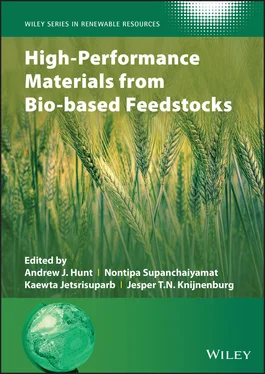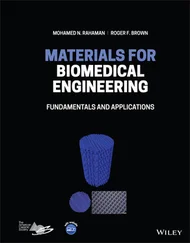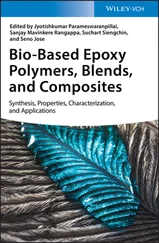High-Performance Materials from Bio-based Feedstocks
Здесь есть возможность читать онлайн «High-Performance Materials from Bio-based Feedstocks» — ознакомительный отрывок электронной книги совершенно бесплатно, а после прочтения отрывка купить полную версию. В некоторых случаях можно слушать аудио, скачать через торрент в формате fb2 и присутствует краткое содержание. Жанр: unrecognised, на английском языке. Описание произведения, (предисловие) а так же отзывы посетителей доступны на портале библиотеки ЛибКат.
- Название:High-Performance Materials from Bio-based Feedstocks
- Автор:
- Жанр:
- Год:неизвестен
- ISBN:нет данных
- Рейтинг книги:5 / 5. Голосов: 1
-
Избранное:Добавить в избранное
- Отзывы:
-
Ваша оценка:
- 100
- 1
- 2
- 3
- 4
- 5
High-Performance Materials from Bio-based Feedstocks: краткое содержание, описание и аннотация
Предлагаем к чтению аннотацию, описание, краткое содержание или предисловие (зависит от того, что написал сам автор книги «High-Performance Materials from Bio-based Feedstocks»). Если вы не нашли необходимую информацию о книге — напишите в комментариях, мы постараемся отыскать её.
High-Performance Materials from Bio-based Feedstocks
The latest advancements in the production, properties, and performance of bio-based feedstock materials
www.wiley.com/go/rrs High-Performance Materials from Bio-based Feedstocks
High-Performance Materials from Bio-based Feedstocks
High-Performance Materials from Bio-based Feedstocks — читать онлайн ознакомительный отрывок
Ниже представлен текст книги, разбитый по страницам. Система сохранения места последней прочитанной страницы, позволяет с удобством читать онлайн бесплатно книгу «High-Performance Materials from Bio-based Feedstocks», без необходимости каждый раз заново искать на чём Вы остановились. Поставьте закладку, и сможете в любой момент перейти на страницу, на которой закончили чтение.
Интервал:
Закладка:
Cinthia J. Meña DuranGreen Chemistry Centre of Excellence, Department of Chemistry, University of York, York, UK
Manunya OkhawilaiMetallurgy and Materials Science Research Institute, Chulalongkorn University, Bangkok, Thailand
Tabitha H.M. PetcheyGreen Chemistry Centre of Excellence, Department of Chemistry, University of York, York, UK
Nawadon PetchwattanaDepartment of Chemical Engineering, Srinakharinwirot University, Nakhon Nayok, Thailand
Uraiwan PongsaDivision of Industrial Engineering Technology, Rajamangala University of Technology Rattanakosin Wang Klai Kang Won Campus, Prachuap Khiri Khan, Thailand
Patcharapol PosiDepartment of Civil Engineering, Rajamangala University of Technology Isan Khon Kaen Campus, Khon Kaen, Thailand
Qiaosheng PuCollege of Chemistry and Chemical Engineering, Lanzhou University, Lanzhou, Gansu, China
Wanwan QuSchool of Chemistry, University of Leicester, Leicester, UK
Ubolluk RattanasakDepartment of Chemistry, Faculty of Science, Burapha University, Chonburi, Thailand
Ismael SaadouneTechnology Development Cell (TechCell), Mohammed VI Polytechnic University (UM6P), Benguerir, Morocco
and
IMED‐Lab, Faculty of Science and Technology, Cadi Ayyad University, Marrakesh, Morocco
Chadamas SakonsinsiriDepartment of Biochemistry, Khon Kaen University, Khon Kaen, Thailand
Janet L. ScottDepartment of Chemistry, University of Bath, Bath, UK
Anu SinghPolymer Research Group, Department of Chemistry, Motilal Nehru National Institute of Technology, Allahabad, Prayagraj, India
Benjatham SukkaneewatDivison of Chemistry, Udon Thani Rajabhat University, Udon Thani, Thailand
Nontipa SupanchaiyamatMaterials Chemistry Research Center (MCRC), Department of Chemistry, Centre of Excellence for Innovation in Chemistry, Faculty of Science, Khon Kaen University, Khon Kaen, Thailand
Alexandra TelekiScience for Life Laboratory, Department of Pharmacy, Uppsala University, Uppsala, Sweden
Vera TrabadeloHigh Throughput Multidisciplinary Research Laboratory (HTMR‐Lab), Mohammed VI Polytechnic University (UM6P), Benguerir, Morocco
Christos TsekouDSM Nutritional Products Ltd., Nutrition R&D Center Forms and Application, Basel, Switzerland
Series Preface
Renewable resources, their use and modification, are involved in a multitude of important processes with a major influence on our everyday lives. Applications can be found in the energy sector, paints and coatings, and the chemical, pharmaceutical, and textile industries, to name but a few.
The area interconnects several scientific disciplines (agriculture, biochemistry, chemistry, technology, environmental sciences, forestry, etc.), which makes it very difficult to have an expert view on the complicated interactions. Therefore, the idea to create a series of scientific books, focusing on specific topics concerning renewable resources, has been very opportune and can help to clarify some of the underlying connections in this area.
In a very fast‐changing world, trends are not only characteristic of fashion and political standpoints; science too is not free from hypes and buzzwords. The use of renewable resources is again more important nowadays; however, it is not part of a hype or a fashion. As the lively discussions among scientists continue about how many years we will still be able to use fossil fuels – opinions ranging from 50 to 500 years – they do agree that the reserve is limited and that it is essential not only to search for new energy carriers but also for new material sources.
In this respect, the field of renewable resources is a crucial area in the search for alternatives for fossil‐based raw materials and energy. In the field of energy supply, biomass‐ and renewables‐based resources will be part of the solution alongside other alternatives such as solar energy, wind energy, hydraulic power, hydrogen technology, and nuclear energy. In the field of material sciences, the impact of renewable resources will probably be even bigger. Integral utilization of crops and the use of waste streams in certain industries will grow in importance, leading to a more sustainable way of producing materials. Although our society was much more (almost exclusively) based on renewable resources centuries ago, this disappeared in the Western world in the nineteenth century. Now it is time to focus again on this field of research. However, it should not mean a “retour à la nature,” but should be a multidisciplinary effort on a highly technological level to perform research towards new opportunities, and to develop new crops and products from renewable resources. This will be essential to guarantee an acceptable level of comfort for the growing number of people living on our planet. It is “the” challenge for the coming generations of scientists to develop more sustainable ways to create prosperity and to fight poverty and hunger in the world. A global approach is certainly favored.
This challenge can only be dealt with if scientists are attracted to this area and are recognized for their efforts in this interdisciplinary field. It is, therefore, also essential that consumers recognize the fate of renewable resources in a number of products. Furthermore, scientists do need to communicate and discuss the relevance of their work. The use and modification of renewable resources may not follow the path of the genetic engineering concept in view of consumer acceptance in Europe. Related to this aspect, the series will certainly help to increase the visibility of the importance of renewable resources. Being convinced of the value of the renewables approach for the industrial world, as well as for developing countries, I was myself delighted to collaborate on this series of books focusing on the different aspects of renewable resources. I hope that readers become aware of the complexity, the interaction, and interconnections, and the challenges of this field, and that they will help to communicate on the importance of renewable resources.
I certainly want to thank the people of Wiley's Chichester office, especially David Hughes, Jenny Cossham, and Lyn Roberts, in seeing the need for such a series of books on renewable resources, for initiating and supporting it, and for helping to carry the project to the end.
Last, but not least, I want to thank my family, especially my wife Hilde and children Paulien and Pieter‐Jan, for their patience, and for giving me the time to work on the series when other activities seemed to be more inviting.
Christian V. Stevens
Faculty of Bioscience Engineering, Ghent University, Belgium
Series Editor, “Renewable Resources”
June 2005
1 High‐performance Materials from Bio‐based Feedstocks: Introduction and Structure of the Book
Kaewta Jetsrisuparb1, Jesper T.N. Knijnenburg2, Nontipa Supanchaiyamat3 and Andrew J. Hunt3
1 Department of Chemical Engineering, Khon Kaen University, Khon Kaen, Thailand
2 International College, Khon Kaen University, Khon Kaen, Thailand
3 Materials Chemistry Research Center (MCRC), Department of Chemistry, Centre of Excellence for Innovation in Chemistry, Faculty of Science, Khon Kaen University, Khon Kaen, Thailand
1.1 Introduction
The overexploitation of the Earth’s resources over the last century has led to a decrease in natural resources, a loss of natural habitat, climate change, and degradation of the environment, resulting in the extinction of several species [1]. The recovery of global economics after COVID‐19 is also driving lifestyle changes, leading to increased high‐performance materials production. As a result, a large number of nonrenewable resources are being utilized, which inevitably contributes to the generation of waste and may lead to detrimental effects to both environment and health. In addition, the scarcity of fossil resources and finite elements with potential global supply chain vulnerabilities are global concerns. Concerns over the supply of natural resources and potential damage to the environment have compelled governments to implement policies that mitigate the risk of further damage. The formation of the World Commission on Environment and Development (WCED) in 1983 and their report called “Our Common Future” in 1987 (also called “Brundtland report”) was one of the catalysts for the move toward a sustainable future for humankind [2]. The definition of sustainable development is the development that “meets the needs of the present without compromising the ability of future generations to meet their own needs” [3]. Importantly, sustainability is a complex balance between societal, economic, and environmental needs, where this must be achieved in unison [4]. Implementation of a bio‐based circular economy including minimizing the waste by recycling materials and utilization of replenishable resources is key to sustainable development.
Читать дальшеИнтервал:
Закладка:
Похожие книги на «High-Performance Materials from Bio-based Feedstocks»
Представляем Вашему вниманию похожие книги на «High-Performance Materials from Bio-based Feedstocks» списком для выбора. Мы отобрали схожую по названию и смыслу литературу в надежде предоставить читателям больше вариантов отыскать новые, интересные, ещё непрочитанные произведения.
Обсуждение, отзывы о книге «High-Performance Materials from Bio-based Feedstocks» и просто собственные мнения читателей. Оставьте ваши комментарии, напишите, что Вы думаете о произведении, его смысле или главных героях. Укажите что конкретно понравилось, а что нет, и почему Вы так считаете.












